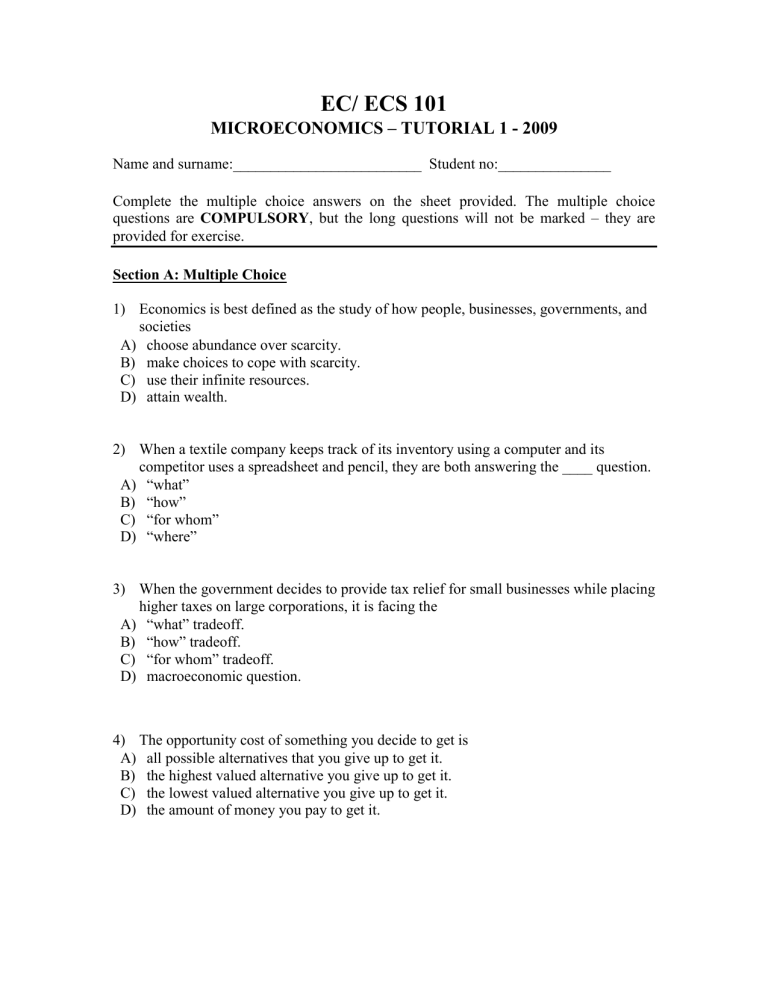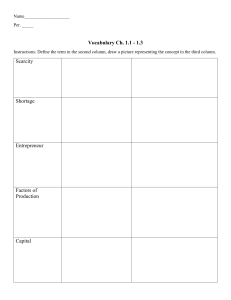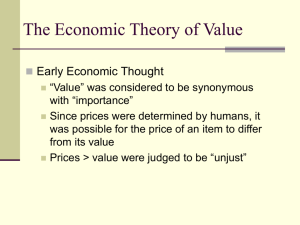
EC/ ECS 101 MICROECONOMICS – TUTORIAL 1 - 2009 Name and surname:_________________________ Student no:_______________ Complete the multiple choice answers on the sheet provided. The multiple choice questions are COMPULSORY, but the long questions will not be marked – they are provided for exercise. Section A: Multiple Choice 1) Economics is best defined as the study of how people, businesses, governments, and societies A) choose abundance over scarcity. B) make choices to cope with scarcity. C) use their infinite resources. D) attain wealth. 2) When a textile company keeps track of its inventory using a computer and its competitor uses a spreadsheet and pencil, they are both answering the ____ question. A) “what” B) “how” C) “for whom” D) “where” 3) When the government decides to provide tax relief for small businesses while placing higher taxes on large corporations, it is facing the A) “what” tradeoff. B) “how” tradeoff. C) “for whom” tradeoff. D) macroeconomic question. 4) The opportunity cost of something you decide to get is A) all possible alternatives that you give up to get it. B) the highest valued alternative you give up to get it. C) the lowest valued alternative you give up to get it. D) the amount of money you pay to get it. 5) A positive statement is A) about what ought to be. B) about what is. C) always true. D) one that does not use the ceteris paribus clause. 6) An economic theory is A) a generalization that summarizes what we understand about economic choices. B) always a mathematical, or nonverbal, model. C) usually more complex than the real world. D) a positive statement that cannot use the ceteris paribus clause. Table 1 x 0 1 2 3 4 5 y 2 5 8 11 14 17 7) Given the information in table 1 above, the relationship between x and y is A) positive, and the curve becomes flatter as x increases. B) positive, and the curve becomes steeper as x increases. C) positive and linear. D) negative and linear. 8) The production possibilities frontier is the boundary between A) those combinations of goods and services that can be produced and those that can be consumed. B) those resources that are limited and those that are unlimited. C) those combinations of goods and services that can be produced and those that cannot. D) those wants that are limited and those that are unlimited. Figure 1 9) Figure 1 above illustrates that if this country wishes to move from its current production point (labeled “Current”) and have 10 more tons of food, it can do this by producing A) 10 more tons of clothing. B) 10 fewer tons of clothing. C) 5 more tons of clothing. D) 5 fewer tons of clothing. 10) If production of two goods is currently at levels such that we are inside the production possibilities frontier A) it is not possible to produce more of both goods B) production is inefficient. C) in order to produce more of one good, we must produce less of the other. D) we are in the “unattainable” region. Table 2 Point A B C D E Production of X 0 3 6 9 12 Production of Y 40 36 28 16 0 11) Table 2 above shows production combinations on a country’s production possibilities frontier. What is the opportunity cost of increasing the production of Y from 16 to 28 units? A) 12 units of good X. B) 6 units of good X. C) 3 units of good X. D) There is no opportunity cost when moving from one point to another along a production possibilities frontier. 12) Resource use is efficient when A) we produce the goods with the highest opportunity cost. B) we produce the goods with the lowest opportunity cost. C) we cannot produce more goods and services. D) we produce the goods we value most highly. Figure 2 13) In figure 2 above, if 2 million computers are produced per year then the A) marginal cost of a computer exceeds the marginal benefit of a computer, so more computers should be produced. B) marginal cost of a computer exceeds the marginal benefit of a computer, so fewer computers should be produced. C) marginal benefit of a computer exceeds the marginal cost of a computer, so more computers should be produced. D) marginal benefit of a computer exceeds the marginal cost of a computer, so fewer computers should be produced. 14) Economic growth is the result of all of the following EXCEPT A) technological change. B) capital accumulation. C) opportunity cost. D) investment in human capital. 15) A person has a comparative advantage in producing a particular good if that person A) has higher productivity in producing it than anyone else has. B) can produce it at lower opportunity cost than anyone else can. C) has less desire to consume that good than anyone else has. D) has more human capital related to that good than anyone else has. 16) The term “market” refers to A) physical structures only. B) locations where buyers and sellers physically meet. C) any arrangement that enables buyers and sellers to get information and trade with one another. D) trading arrangements that have been approved by the government. 17) The law of demand states that the quantity of a good demanded varies A) inversely with its price. B) inversely with the price of substitute goods. C) directly with income. D) directly with population. 18) Good A and good B are substitutes in production. The demand for good A increases so that the price of good A rises. The increase in the price of good A shifts the A) demand curve for good B leftward. B) demand curve for good B rightward. C) supply curve of good B leftward. D) supply curve of good B rightward. 19) When the price is below the equilibrium price, the quantity demanded A) is less than the equilibrium quantity. So is the quantity supplied. B) is less than the equilibrium quantity. The quantity supplied exceeds the equilibrium quantity. C) exceeds the equilibrium quantity. So does the quantity supplied. D) exceeds the equilibrium quantity. The quantity supplied is less than the equilibrium quantity. Table 3 Price (rands per disc) 4 8 12 16 20 24 28 32 36 Quantity demanded 36,000 32,000 28,000 24,000 20,000 16,000 12,000 8,000 4,000 Price (rands per disc) 4 8 12 16 20 24 28 32 36 Quantity supplied 4,000 8,000 12,000 16,000 20,000 24,000 28,000 32,000 36,000 20) Table 3 above gives the demand and supply schedules for compact discs. If the price of a compact disc is R8, there is a ____ and the price of a compact disc will ____. A) shortage; rise B) shortage; fall C) surplus; rise D) surplus; fall [2*20 = 40] Section B: Long Questions 1) What is the difference between positive and normative statements? (5) 2) Explain, with the help of an illustration, the circular flows within the market economy. Be sure to explain every existing flow on your diagram. (10) [15] Memorandum: EC101 Tutorial 1 2009 Section A: Multiple Choice 1. 2. 3. 4. 5. 6. 7. 8. 9. 10. 11. 12. 13. 14. 15. 16. 17. 18. 19. 20. B B C B B A C C D B C D C C B C A C D A Section B: Long Questions 1. Positive statements tell what is and normative statements tell what ought to be. Positive statements can be tested to determine if they are correct or not, while normative statements use value judgments and so cannot be tested. Give an appropriate example of each. (5) 2. The circular flows in the market economy represent flows between households and firms through the goods and factor markets. The four flows illustrated, include the following: a) Households provide their FOP to firms through the factor markets (2 marks) b) Firms pay for these FOP through the factor markets (2 marks) c) With this income, households buy G & S from firms through the goods markets (2 marks) d) Firms produce G & S and provide them to households through the goods markets (2 marks) BE SURE TO INCLUDE THE DIAGRAM… (2 marks if neat and accurate) (10)







